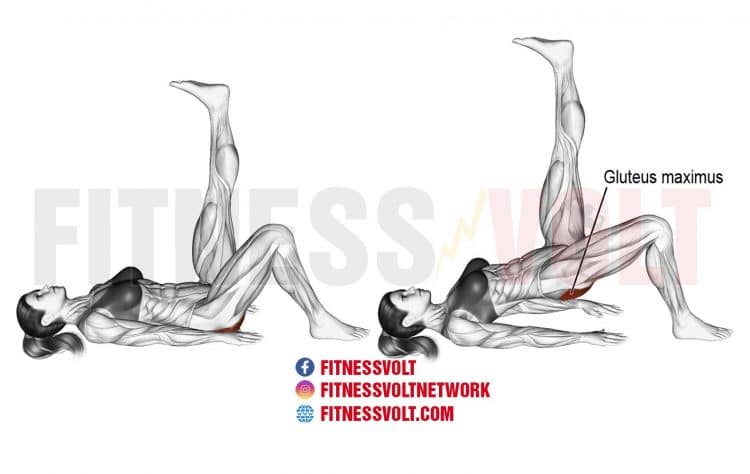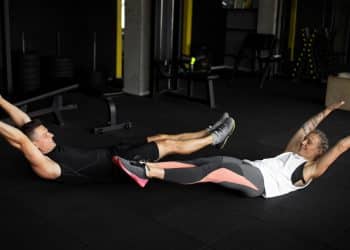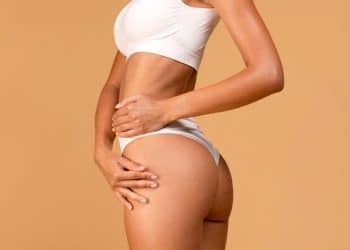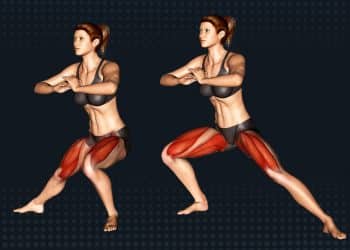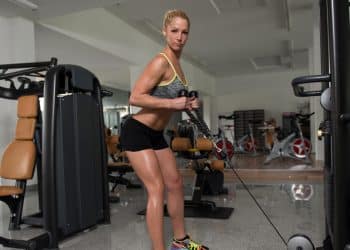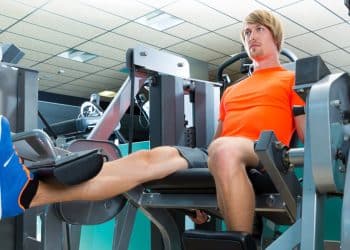The single leg glute bridge is a bodyweight variation of a superior weighted posterior chain movement also known as hip thrusts. There are many advantages to training your butt, hamstrings and glutes while lying on your back, namely that the hips are forced to play a bigger role than the quadriceps muscles in facilitating the movement.
Glute bridges are the perfect choice for advanced beginners and intermediates who can still benefit from using simple bodyweight variations to progress their workouts and prepare them for the bigger movements.
Check out our full single leg glute bridge exercise guide that includes training tips, a list of benefits, best variations, recommended sets and reps and more.
In this exercise:
- Target muscles: Gluteus maximus
- Type: Hypertrophy, strength, and stability
- Mechanics: Compound
- Equipment: Bodyweight
- Difficulty: Intermediate
How To Do Single Leg Glute Bridges
If you’ve mastered the two-legged glute bridge, the single leg version isn’t much different although certainly more difficult. However, if you’ve never done this exercise and want to make sure you’re doing it correctly, we provided a step-by-step breakdown of the technique below.
Step 1: Setup
- Lie on your back, arms down by your sides, knees propped up and feet flat on the floor. Contract your ab muscles and roll your pelvis under to flatten your lower back on the ground.
Step 2: Glute Bridge
- Lift one leg up at a roughly 45-degree angle to the floor and extend it straight out as shown in the video example below. Tighten your abs then push your hips up as high as you comfortably can without hyperextending your lower back. Make sure to keep your glutes engaged.
Step 3: Finish and repeat
- Slowly lower your butt down to the floor, repeat for the desired number of repetitions then do the same with your other leg.
If you have a few minutes to spare, also check out this great video instructional to see a detailed demonstration of single leg glutes bridges.
Single Leg Glute Bridge Benefits
Why would you want to incorporate single leg glute bridges in your workouts?
Strengthen your glutes and posterior
Your butt muscles are more than just for show. They play an important functional role in movement of the lower body. However, sitting on our tooshies all day and not training them much is a recipe for weak buns that affect function and range of motion in other muscle groups and surrounding joints.
Glute bridges also fire up the posterior chain muscles as a whole from the back down to your calf muscles. The backside muscles tend to get less attention probably because we don’t see them. But they’re just as important.
Related: The 15 Best Glute Isolation Exercises for a Stronger, Shapelier Butt
Maintain healthy and functional hips
Everything from weight training to physical activities and bending down to tie your shoe laces requires healthy and functional hips. As we get older bones start to lose their density and hence increase the risk of injury. Strength training has shown to not just strengthen muscles but decelerate bone loss as well.
Progression to weighted hip thrusts
Progression is standard procedure for getting better at anything. Not everyone is ready to jump straight into weighted hip thrusts and that’s why bodyweight bridges have an important place. You’ll learn how to use your muscles together for efficient movement of the hips and lower body.
The when you have bodyweight glute bridges down pat you can introduce a loaded barbell to maximize your lower posterior chain development.
Bodyweight-only
The main advantages of an exercise like single leg glute bridges is that you can do them on one leg to make them more challenging and they can be done anywhere. You don’t need any equipment or training except for a soft surface (ideally) to lie on.
Drawbacks
What are the potential cons of single leg glute bridges? Here are two.
Not an advanced exercise
For some people, single leg glute bridges are much too easy and not worth the time or effort. Although, it will take some time to get there because if you do them with enough focus and a slower tempo, intermediate and advanced exercisers may benefit from adding them near the end of a workout or if they need a bodyweight glute-focused exercise. It’s important to note though, that your bodyweight is a factor in the number of reps you can perform. Therefore, bigger and stronger individuals with some training may find that their weight provides a decent amount of resistance.
Lose potency over time
Bodyweight exercises eventually lose their effectiveness if you do them enough. After about 25 reps or so, you’re no longer challenging the muscles and as a result, they won’t adapt much, get stronger or increase in size. However, for single leg glutes bridges, there are several advanced variations that will allow you to keep progressing.
Common Mistakes
If you want to make single leg glute bridges work for you, avoid these common form mistakes.
Arching your lower back – Oftentimes weak hip flexors will cause an arched lower back while in the lying position. This is the first thing you need to fix when setting up for single leg glute bridges. Remember to roll your pelvis under until there’s no space between your trunk and the floor.
Allowing your hips to shift – A lack of core strength and stability can cause the hips to shift in the left or right direction. If this is you, revert back to the double leg glute bridge and work on this area of fitness before attempting the single leg variation.
Not activating the core and glutes – Total body stability and glute engagement are key to this movement. Make sure to keep your core tense and squeeze those cheeks until you’ve completed your set.
Variations
The single leg glute bridge serves a special purpose but you should also consider these other variations that come with their own advantages.
Glute bridge
Before you graduate to the single leg glute bridge, first go through basic posterior chain training by starting with the two-legged version. It’s the perfect beginner exercise that’ll help you to learn proper hip movement which is an essential part of many advanced exercises.
Feet elevated single-leg glute bridge
A simple way to make this exercise harder and get more range of motion is to elevate your feet up onto a raised platform like a bench, chair, foam roller or something similar. You should feel an enhanced contraction in your glutes with this variation.
Barbell hip thrusts
The king of glute bridge variations, barbell or weighted hip thrusts are, in our opinion, the epitome of butt-building greatness. Different from any other lower body movement, the bar sits on the hips rather than the trapezius muscles or the floor.
Also check out these 10 Best Hip Thrust Alternatives for a Stronger Posterior Chain.
Banded glute bridge
Here’s an alternative to the barbell hip thrust highly recommended by “The Glute Guy” Bret Contreras. Wrap a band around your hips and secure the other end to a dedicated hip thruster bench, power rack or a setup that will work for this exercise.
You can start out with a light resistance band, but Contreras suggests progressing to thicker bands that will keep you in a target range of 3 sets x 20 reps for the band variation.
To do it:
- Seated on the floor with your upper back and elbows on the bench and band over your hips, lift your hips as high as you can and drive your feet into the ground. Keep your chin tucked down into your chest to keep your ribs down, and torso flat to encourage a slight posterior pelvic tilt in the glutes. Squeeze hard at the top, drop your butt to within a few inches of the floor and repeat.
Watch the video example below.
Alternatives
Variations involve a similar setup and movement pattern to single leg glute bridges. These variations are entirely different movements but they work all the same muscle groups. And actually, you may prefer them over glute bridges and hip thrusts.
Romanian deadlift
When it comes to posterior chain exercises, the Romanian deadlift (RDL) stands above the rest. It’s not as taxing on the body compared to conventional deadlifts, and consequently tends to be a preferred exercise. RDLs use a shorter range of motion stopping the bar mid-shin before.
Lunges
Single leg glute bridges are a fantastic exercise but lunge variations are more versatile and likely just as effective. It’s also easier to tack on more weight to lunge movements because you can use heavy dumbbells.
Bulgarian split squat
It’s like a lunge on steroids… Bulgarian split squats are, in our opinion, a superior mass and strength building exercise because it more resembles a upright single leg squat, whereas lunges occur in a forward and backward movement. They’re also always lower impact, especially if you perform lunges by lifting and planting your feet.
There are also a few variations of Bulgarians including the forward leaning version which we really like because it involves more hip hinge to activate more of the posterior chain overall.
How To Program Single Leg Glute Bridges
If you’re considering programming single leg glute bridges then you’re most likely a beginner to intermediate exerciser or need a bodyweight variation to supplement weight and machines leg workouts. It can be an excellent addition to your training and a progression to more advanced exercise variations.
We recommend single leg glute bridges after your main compound lifts (e.g., weighted squats, deadlift variations, etc), or in addition to a complete home leg workout routine.
Sets and Reps
Your level of training experience typically determines the “optimal” number of sets and reps. However, because single leg glute bridges are typically a beginner bodyweight-only exercise, you’ll likely get the most benefit from higher volume training. If the exercise is too easy, you won’t do much.
Not to mention, research has shown that higher reps taken to failure can be just as effective for muscle growth as higher weights and fewer reps (1).
- Aim for 2-4 sets of 15-30 reps.
Muscles Worked
Single leg glute bridges work all of the posterior chain muscles from your neck all the down your feet. Although, it primarily targets the lower body, core and back muscles. Learn about the anatomy of muscles involved in this bodyweight movement.
- Gluteus Maximus – Gluteus maximus is the largest and most superficial muscle that makes up the majority of the size, shape, and appearance of the butt and hip muscles. It’s a prominent functional and aesthetic muscle group. The butt primarily extends and externally rotates the thighs and it plays an important role in helping us to maintain an upright posture.
- Quadriceps – The quadriceps or quads for short is the large group of muscles that make up most of your upper leg mass. It has four heads; rectus femoris, vastus lateralis, vastus medialis, and vastus intermedialis. These muscles help to flex the hips and extend the knees during movements such as squats. They’re also important for posture, walking, and the function of the spine and pelvis.
- Hamstrings – The hamstrings is a three-headed muscle group consisting of semitendinosus, semimembranosus, and biceps femoris. Located on the back of the upper leg opposite the quads, they function to extend the hips and flex the knees. The short head of the biceps femoris only crosses the knee joint and not the hip like the other two muscles.
- Calves – The calves make up the lower leg muscles below the knee. They function to point the toes down and are athletic muscles. All compound leg movements involve the calves.
- Core/abs – The core consists of several muscles – abs (curls the pelvis and rib cage toward each other), obliques (located on either side of the abs and rotate the torso), deeper core muscles (transverse abdominis and internal obliques draw the belly button to the spine and stabilize the trunk), back extensors (allow us to stand up straight from a bent-over position and lean backward).
Bottom Line
The next time you’re trying to figure out a way to train your glutes without squats or weights, give single leg glute bridges a try. In its basic form you may find it to be a beginner movement, however, if you want to soup it up, we’ve also shared a few harder variations that you can do.
Hopefully this guide will serve you well in programming a variety of glute and lower body movements in your workout regime.

